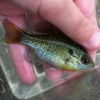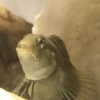so, my wife and daughter are starting a new triops tank. now, it isn't a north american native, but it got me thinking about triops here... and when i looked, i didnt see anything that had a lot of good information about keeping them.
i have been keeping T. longicaudatus for about 20 years now. in fact, i have taken them with me on every deployment so far, and have grown them in four countries and three different continents(including north america). actually, i am deployed now and i just dried up the sand after my last triops died(so make that five countries, including the USA). the T. longs are descendants from one of those "triassic triops" kits i got about 20 years ago. i was keeping them in an old plastic pretzel container, with a lamp from my room rigged up all bass akwards to provide light. here is a pic: https://ibb.co/e83aLd
fancy, right? well, anyway, i figured i might as well write a thread about how i keep them. one thing i noticed early on was that there wasn't very good information on the internet about keeping them. the instructions that come with the kits are pretty terrible... following them to the letter usually results in triops that end up starving to death well before they mature. since my wife and daughter just set up a triops tank, ill have her send some pics later so that i can post them here, but in the mean time, ill give the basic set up so that anyone who is interested in keeping them has a decent chance of success at keeping them.
ah! but where to start? i have been keeping and experimenting with these critters for two decades, there is a lot i can say about them...
ok, ill start with the basic setup. then, later on, i think ill go into why i set triops tanks up the way i do. so....
setting up the tank: this is fairly simple. first, get sand, any kind so long as it is fairly fine. gravel doesn't work so well because triops have a hard time digging in it and small triops get stuck under pebbles and such. about an inch at the bottom of the tank is fine, but you can really add as much as you want. you don't have to clean the sand so long as it is free of chemicals, but rinsing it does help with being able to see them when they get larger. on top of the sand, sprinkle some crushed oyster shell, crushed coral, or crushed limestone. it doesn't have to be a layer in its own right, it just needs to be enough to affect the water quality a bit. i have kept triops in pure aragonite sand before, so you don't really have to worry about adding too much, unless the grain size is large enough to present the same issues previously mentioned regarding gravel.
ok, so now that the substrate is out of the way, on to prepping the tank to receive nauplii. basically, you are going to want to give them a food source. it needs to be small enough for them to eat, but also needs to be something that will not foul the water. i find there are two things that work well for this: green water, and simple mud. green water is the best way to go, since it certainly isnt going to foul so long as you keep a light on the tank. but, mud works good too. mud that comes from the edge of a pond or lake workes best, since it already has all kinds of little microbes that are already happy with living in water. that said, i find it best to mix it with some water and pour it through a mesh first to remove any predatory bugs that might eat the nauplii. plus, that also catches larger objects that might look unsightly. how much do you need? well, i typically gauge that based on how many inches of water i can see through. it should be enough to reduce visibility to about a foot. it doesnt have to be exact, the water just needs to be a little dirty. dont worry, it will clear up in a few days. something else that works well is taking a clump of hair algae and wringing the water out of it a bit. the resulting green slurry works well for feeding them without fouling the water up.
add a light to it and an air stone. the air stone should be up near the top inch of water, really just enough to break up the surface tension and move water around a little bit. as for the water that should go into the tank, it can be tap water or old fish tank water. its not that important so long as it is chemical free, so no chlorine or chloramines. now, after the tank is full, a light is on it, and the air stone is bubbling away, onto hatching the triops...
take the triops eggs and put them into a bottle of distilled or RO water. it needs to be water with a very low osmotic pressure(high solvent/low solute concentration). fill the bottle up until there is just barely a bubble left in the bottle. the idea is to make sure the eggs stay in contact with the water. let it sit for about 8 hours and the eggs will be fully hydrated. now, here is the interesting thing about triops, and i imagine its true of other branchiopods as well: once the eggs are hydrated, they will hatch in just about any kind of water. i have soaked eggs in distilled water before and then dropped them into tanks set up with soft acidic water and tanks with alkaline liquid rock in it. so long as i soaked them in distilled water first, they hatched in the tank. one caveat on soaking them though... if the eggs are already wet enough to sink when you put them into the bottle of distilled water, only leave them in for about three hours. i have seen eggs hatch within four or five hours before when they were already fairly wet.
after they are done soaking, pour them into the tank and then just leave the light on and do nothing. at all. don't clean the tank, don't do water changes, don't feed them, don't do anything but watch them. they will grow pretty quickly. when they get to be about a centimeter long, you can start feeding them. i typically feed them stuff that decays slowly, like tiny pieces of carrot, a couple grains of rice, etc. the biggest thing is to leave the light on and don't turn it off. the light will cause algae to bloom, and so long as it stays on, it will dramatically reduce any issues with water quality.
and that is pretty much it. with triops, you can often get away with even simpler ways to set them up, but i find the above set up to be a decent base line that always works.
i really like experimenting with these little guys. for instance, i had read that they hatch best in water with fairly neutral ph, but i wondered if either of the wild extremes would stop them from hatching after they had already hydrated. i found that the ph at inundation is all that seems to matter to them. im sure there is an upper and lower limit, but its nothing outside of what you might find in tap water. in NC i have had tap water at a ph of about 6, while in CA it was just a touch over 8. again, it didn't matter so long as i soaked them. in fact, nothing about the water seemed to stop them from hatching after they were hydrated, even if they were not able to survive once hatched.
something else i want to experiment with that i haven't gotten around to yet is testing whether triops will discriminate between their own eggs and other branchiopod eggs. i have seen them eat brine shrimp eggs, so i know they eat eggs, but im not sure if they will discriminate against their own eggs. i would probably want to test triops eggs in general, and then test a particular triops own eggs. i imagine they would just chomp down on them if they had nothing else, but you never know. they might surprise me. getting pure triops eggs is not too difficult. i used to collect pure eggs by adding saturated brine solution to wet egg laden sand. the higher density would cause the eggs to float up to the surface as i stirred the sand up, and from there it was easy to collect them, rinse them, and dry them out.
anyway, they are neat little critters that i have enjoyed keeping for a long time, so i figured i would let people know a fairly simple way of keeping them. at some point, i want to get Triops newberryi, and if at all possible, some of the native lepidurus species. newberryi seems to be available on the internet, but i haven't seen any lepidurus species being offered in quite a while...
until then, ill keep raising generation after generation of T. longicaudatus while adding some of the other species to my collection.
Edited by Auban, 18 May 2018 - 01:55 AM.










